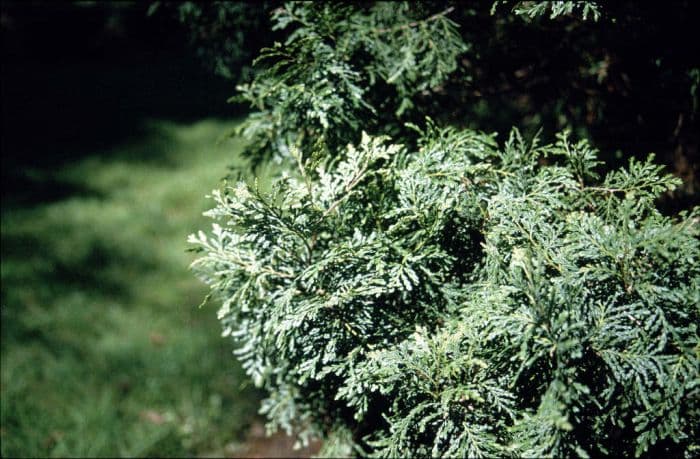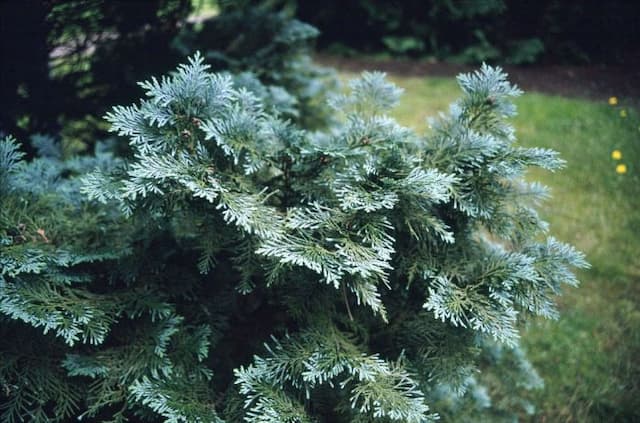Chilean Cedar Austrocedrus chilensis

ABOUT
The Chilean cedar is a coniferous tree with a distinctive appearance. It has a conical shape with a broad and sometimes irregular crown. The foliage of the Chilean cedar consists of small, scale-like leaves that are arranged in opposite pairs, forming flattened sprays with a soft texture. These leaves range in color from a deep green to a grayish-green, and they may take on a bronze hue during colder months. The tree's bark is another prominent feature. It's thick and fibrous with deep furrows and a reddish-brown to gray color, providing a rugged texture to the trunk. Over time, the bark may peel off in vertical strips, adding to the tree's character. As for the reproductive elements, the Chilean cedar produces small, inconspicuous male cones and larger, more noticeable female cones. The female cones are initially green, taking on a brown shade as they mature. They have a woody texture and feature several scales that protect the seeds within. The Chilean cedar's branches are sturdy and horizontal, often extending from the trunk to create a wide base. The overall shape and structure of the tree contribute significantly to its ornamental value, making it a visually appealing addition to gardens and landscapes where it can grow successfully.
About this plant
 Names
NamesFamily
Cupressaceae
Synonyms
Chilean Cedar, Chilean Incense Cedar, Cordilleran Cypress
Common names
Libocedrus tetragona, Thuja chilensis, Libocedrus chilensis, Fitzroya tetragona, Thuja andina, Libocedrus andina, Austrocedrus chilensis var. macrocarpa.
 Toxicity
ToxicityTo humans
The most common name of Austrocedrus chilensis is Chilean cedar. There is limited information on the toxicity of Chilean cedar to humans. It does not appear to be commonly known for being poisonous or causing severe toxic effects if ingested. However, given that comprehensive data might not be readily available, it is generally advisable to exercise caution and avoid ingesting parts of plants that are not known to be safe or are not commonly consumed as food.
To pets
The most common name of Austrocedrus chilensis is Chilean cedar. Similar to its effects on humans, there is no widely reported toxicity of Chilean cedar to pets. However, the lack of information does not guarantee that it is safe, and caution is still recommended. Pets should not be allowed to ingest parts of plants that are not known to be non-toxic. If a pet does consume any part of the Chilean cedar, monitoring them for any signs of distress or illness and consulting a veterinarian would be prudent.
 Characteristics
CharacteristicsLife cycle
Perennials
Foliage type
Evergreen
Color of leaves
Green
Height
30 feet (9 meters)
Spread
15 feet (4.5 meters)
Plant type
Tree
Hardiness zones
7
Native area
South America
Benefits
 General Benefits
General Benefits- Erosion Control: The extensive root system of Austrocedrus chilensis, commonly known as the Chilean cedar, helps stabilize soil and prevent erosion, particularly in mountainous regions where it is native.
- Windbreak: It can act as a windbreak, protecting smaller plants and reducing wind speed in agricultural or residential areas.
- Timber Production: The wood is valued for construction and carpentry due to its durability, resistance to decay, and pleasant aroma.
- Habitat Creation: Its foliage and structure provide habitat and nesting sites for various bird species and other wildlife.
- Aesthetic Value: The Chilean cedar's conical shape and evergreen foliage make it an attractive ornamental plant for landscaping and parks.
- Cultural Significance: It holds cultural importance for indigenous peoples and is considered a symbol in certain local traditions.
- Shade Provider: Its dense canopy offers shade, making it suitable for planting in recreational areas and protecting undergrowth plants.
 Medical Properties
Medical Properties- Antimicrobial activity: Extracts of Austrocedrus chilensis have been studied for their potential antibacterial and antifungal properties.
- Anti-inflammatory effects: Some research indicates that components within the plant may have anti-inflammatory properties.
 Air-purifying Qualities
Air-purifying QualitiesThis plant is not specifically known for air purifying qualities.
 Other Uses
Other Uses- The wood of the Chilean cedar can be used for making musical instruments due to its acoustic properties.
- Fine crafts such as jewelry boxes and intricate carvings are often made from Chilean cedar because of its workability and finish.
- Chilean cedar wood shavings are sometimes utilized as a natural insect repellent in closets and drawers.
- The wood's unique aroma is valued in the creation of scented sachets that provide a natural fragrance.
- In beekeeping, the wood can serve as a construction material for beehives because of its durability and natural resistance.
- Fences and outdoor structures like pergolas and trellises are constructed from Chilean cedar due to its resilience to weathering.
- Specialty papers and packaging materials may incorporate its fibers for added strength and texture.
- The tree's resin is used in traditional varnishes and as a natural adhesive in some crafting practices.
- Chilean cedar sawdust can be compressed into wood pellets for use as biofuel or in wood pellet stoves for heating.
- Chilean cedar bark is sometimes incorporated into landscaping mulches for its aesthetic appearance and natural decomposition benefits.
Interesting Facts
 Feng Shui
Feng ShuiThe Chilean cedar is not used in Feng Shui practice.
 Zodiac Sign Compitability
Zodiac Sign CompitabilityThe Chilean cedar is not used in astrology practice.
 Plant Symbolism
Plant Symbolism- Resilience - Austrocedrus chilensis, commonly known as the Chilean cedar, can thrive in harsh environments reflective of an ability to persist and overcome adversity.
- Endurance - The Chilean cedar's long lifespan signifies the quality of enduring or sustaining hardships and the passage of time with strength.
- Protection - Traditionally, trees have been symbols of shelter and safety; given the sturdy nature of the Chilean cedar, it may be seen as a symbol of protection against the elements or other dangers.
 Water
WaterFor the Chilean Cedar, it's crucial to maintain consistently moist soil without over-saturating it. Water the plant once a week with about 1.5 gallons during active growth periods in spring and summer. In the fall and winter, reduce watering to every other week, using about 1 gallon each time, adjusting for rainfall and climate conditions to prevent root rot. Always allow the top layer of soil to dry out slightly before the next watering to encourage healthy root growth.
 Light
LightThe Chilean Cedar prefers full sun to partial shade. For optimal growth, it should be placed in a location where it can receive at least six hours of direct sunlight daily but is protected from the harsh afternoon sun. This ensures the tree gets sufficient light without being damaged by excessive heat.
 Temperature
TemperatureThe Chilean Cedar thrives in a range of temperatures, from a minimum of about 20°F to a maximum of 80°F. The ideal growing conditions, however, are between 60°F and 70°F. While the tree can withstand occasional dips below 20°F, it’s best to protect it from prolonged freezing temperatures to prevent damage to the foliage and roots.
 Pruning
PruningPrune the Chilean Cedar to maintain its shape and remove any dead or damaged branches. This should be done in the later winter or early spring before new growth begins. Pruning at this time allows for the least impact on the tree’s health and ensures a robust growth season. It's not necessary to prune annually; instead, evaluate the tree's condition each year to determine the need for pruning.
 Cleaning
CleaningAs needed
 Soil
SoilThe best soil mix for growing the Chilean cedar is well-draining with some organic matter to retain moisture. Adequate drainage is paramount to avoid root rot, so incorporating sand or perlite into a loam-based soil can promote good soil structure. The soil pH should be slightly acidic to neutral, ranging from 6.0 to 7.5.
 Repotting
RepottingThe Chilean cedar, being a slow-growing tree, does not need frequent repotting. It should be repotted every 3 to 4 years, or when it becomes root-bound. Spring is the best time to repot this plant to minimize stress and allow for growth in the growing season.
 Humidity & Misting
Humidity & MistingChilean cedar thrives in moderate to high humidity levels. The best humidity range for this plant is between 40-70%. If grown indoors, it may benefit from a light misting or a nearby humidifier to maintain optimal humidity.
 Suitable locations
Suitable locationsIndoor
Place the Chilean cedar in bright light, and maintain good air flow.
Outdoor
Plant in well-drained soil, sun or partial shade, and protect from winds.
Hardiness zone
7-10 USDA
 Life cycle
Life cycleThe life of Austrocedrus chilensis, commonly known as the Chilean cedar, begins with seed germination, which occurs typically in a moist, well-drained soil environment. Once the seedling emerges, it enters a period of juvenile growth, developing a strong root system and foliage. As it matures into an adult tree, it exhibits a slow growth rate, forming a distinctive conical shape with dense, dark green scale-like leaves. Chilean cedar reaches reproductive maturity and starts producing female and male cones separately on the same tree; pollen from male cones is carried by the wind to fertilize female cones. Upon successful fertilization, seeds develop within the female cones over a period, which then disperse to give rise to new seedlings. The Chilean cedar can live for several hundred years, continuing this cycle and slowly expanding its range through seed dispersal.
 Propogation
PropogationPropogation time
Late winter-early spring
Propogation: The most popular method of propagating the Chilean cedar, or Austrocedrus chilensis, is through seed germination. Propagation is best undertaken in the spring season when the temperature begins to rise, providing a conducive environment for seed growth. Seeds are usually collected from mature cones and then subjected to a stratification process, which involves exposing them to a period of cold to break dormancy. After stratification, seeds are sown in well-draining soil and lightly covered with a thin layer of sand or soil to maintain moisture levels. They require consistent moisture and should be kept in a bright, indirect light environment until germination occurs. It's crucial to avoid letting the seeds dry out during this period; a light misting can help maintain the necessary humidity. Seedlings can be transplanted to individual pots once they've developed a few sets of true leaves and are sturdy enough to handle.









